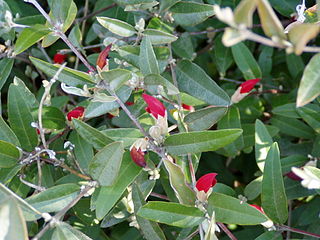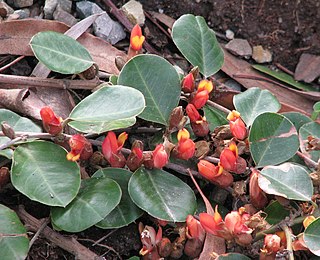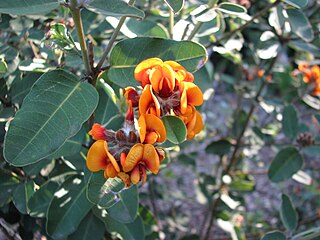
Gastrolobium is a genus of flowering plants in the family Fabaceae. There are over 100 species in this genus, and all but two are native to the south west region of Western Australia.

Gastrolobium melanopetalum is a shrub in the family Fabaceae which is endemic to the south-west of Western Australia.

Gastrolobium praemorsum is a scrambling shrub which is endemic to the south-west of Western Australia. It is a member of the family Fabaceae and produces red pea-flowers from late winter to early summer. It is not known whether this species shares the toxic properties of many other members of the genus Gastrolobium.

Gastrolobium bilobum, commonly known as heart-leaved poison, is a bushy shrub which is endemic to south west Western Australia.

Gastrolobium celsianum, the Swan River pea, is a low-growing shrub which is endemic to Western Australia.

Gastrolobium sericeum is a flowering plant in the family Fabaceae. It is endemic to the south-west of Western Australia. It is a prostrate, low shrub with pendulous yellow, green, red or nearly black pea-flowers from spring to summer.

Gastrolobium grandiflorum, commonly known as wallflower poison, wallflower poison bush or heart-leaf poison bush, is a bushy shrub which is endemic to Australia.

Gastrolobium spinosum, also known as prickly poison, is a shrub in the family Fabaceae. It is endemic to Southwest Australia

Gastrolobium lehmannii, the Cranbrook pea, is a vulnerable shrub in the family Fabaceae which is endemic to an area of Western Australia.
Gastrolobium rubrum is a shrub in the family Fabaceae. It is endemic to the south west of Western Australia.

Gastrolobium minus, also known as broad-leaved brachysema, is a prostrate shrub which is endemic to the south-west of Western Australia. It is a member of the family Fabaceae and of the genus Gastrolobium, which contains many toxic species, however the toxicity of this species is unknown.

Gastrolobium coriaceum is a shrub species in the family Fabaceae. It is endemic to the south west of Western Australia.
Gastrolobium brevipes is a shrub that is endemic to the Central Ranges region of Western Australia, Northern Territory and South Australia. It is a member of the family Fabaceae, grows to 2.5 metres high and produces orange red pea-flowers in July.

Michael Douglas Crisp is an emeritus professor in the Research School of Biology at the Australian National University located in Canberra. In 1976 he gained a PhD from the University of Adelaide, studying long-term vegetation changes in arid zones of South Australia. In 2020 Professor Crisp moved to Brisbane where he has an honorary position at the University of Queensland. Together with others he has revised various pea-flowered legume genera.
Lindy Webster Cayzer CF is an Australian botanist.

Gastrolobium formosum is a small, trailing shrub, with red flowers, in the pea family (Fabaceae), which grows up to a metre high, on clays and loam in swamps and along river banks. The inflorescence consists of head of four unstalked flowers which is sheathed by a whorl of large bracts, with the flower petals being obscured by the lower calyx lobes. The standard petal is less than on third the keel petal. It is native to the south-west of Western Australia.

Gastrolobium nervosum is a small shrub in the pea family (Fabaceae), native to Western Australia.

Gastrolobium rigidum is a small bushy shrub in the pea family (Fabaceae), native to Western Australia.
Daviesia eurylobos is a species of flowering plant in the family Fabaceae and is endemic to the south-west of Western Australia. It is a spreading shrub with somewhat crowded, egg-shaped to elliptic phyllodes, and yellow and red flowers.

Daviesia rubiginosa is a species of flowering plant in the family Fabaceae and is endemic to inland areas of south-western Western Australia. It is a broom-like, glabrous to glaucous shrub with scattered, linear to cylindrical phyllodes, and orange-yellow and red flowers.















